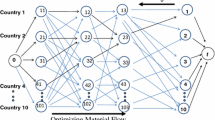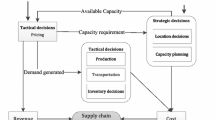Abstract
We present a planning model for chemical commodities related to an industry case. Commodities are standard chemicals characterized by sales and supply volatility in volume and value. Increasing and volatile prices of crude oil-dependent raw materials require coordination of sales and supply decisions by volume and value throughout the value chain to ensure profitability. Contract and spot demand differentiation with volatile and uncertain spot prices, spot sales quantity flexibility, spot sales price–quantity functions and variable raw material consumption rates in production are problem specifics to be considered. Existing chemical industry planning models are limited to production and distribution decisions to minimize costs or makespan. Demand-oriented models focus on uncertainty in demand quantities not in prices. We develop an integrated model to optimize profit by coordinating sales quantity, price and supply decisions throughout the value chain. A two-phase optimization approach supports robust planning ensuring minimum profitability even in case of worst-case spot sales price scenarios. Model evaluations with industry case data demonstrate the impact of elasticities, variable raw material consumption rates and price uncertainties on planned profit and volumes.
Similar content being viewed by others
References
Asche F, Gjölberg O, Völker T (2003) Price relationships in the petroleum market: an analysis of crude oil and refined product prices. Energy Econ 25: 289–301
Bartodziej P, Derigs U, Zils M (2007) O&D revenue management in cargo airlines—a mathematical programming approach. OR Spectrum 29: 105–121
Berning G, Brandenburg M, Gürsoy K, Mehta V, Tölle FJ (2002) An integrated system solution for supply chain optimization in the chemical industry. OR Spectrum 24: 371–401
Biller S, Chan LMA, Simchi-Levi D, Swann J (2005) Dynamic pricing and the direct-to-customer model in the automotive industry. Electron Commerce Res 5: 309–334
Blömer F, Günther H-O (2000) LP-based heuristics for scheduling chemical batch process. Int J Product Res 38: 1029–1051
CEFIC (2005) Facts and figures—the European chemical industry in a worldwide perspective: July 2005. The European Chemical Industry Council, Brussels
Chakravarty AK (2005) Global plant capacity and product allocation with pricing decisions. Eur J Oper Res 165: 157–181
Chen C, Lee W (2004) Multi-objective optimization of multi-echelon supply chain networks with uncertain product demands and prices. Comput Chem Eng 28: 1131–1144
Defregger F, Kuhn H (2007) Revenue management for a make-to-order company with limited inventory capacity. OR Spectrum 29: 137–156
Dickersbach JT (2006) Supply Chain management with APO: structures, modelling approaches and implementation peculiarities, 2nd edn. Springer, Berlin
Gosavi A, Ozkaya E, Kahraman AF (2007) Simulation optimization for revenue management of airlines with cancellation and overbooking. OR Spectrum 29: 21–38
Grunow M (2001) Management von Produktions- und Distributionsnetzwerken in der chemischen Industrie. In: Sebastian H, Grünert T (eds) Logistikmanagement—supply chain management and electronic business. Teubner, Stuttgart, pp 323–335 (in German)
Grunow M, Günther H-O, Yang G (2003) Plant co-ordination in pharmaceutics supply networks. In: Günther HO, van Beek P (eds) Advanced planning and scheduling solutions in process industry. Springer, Berlin, pp 261–294
Gupta A, Maranas CD (2003) Managing demand uncertainty in supply chain planning. Computers Chem Eng 27: 1219–1227
Kallrath J (2002) Planning and scheduling in the process industry. OR Spectrum 24: 219–250
Kallrath J (2002b) Gemischt-ganzzahlige Optimierung: Modellierung in der Praxis. Vieweg, Braunschweig. (in German)
Kilger C, Wagner M (2008) Demand planning. In: Stadtler H, Kilger C (eds) Supply chain management and advanced planning, 4th edn. Springer, Berlin, pp 133–160
Lee LH, Chew EP, Sim MS (2007) A heuristic to solve a sea cargo revenue management problem. OR Spectrum 29: 123–136
Marquez AC, Blanchar C (2004) The procurement of strategic parts. Analysis of contracts with suppliers using a system dynamics simulation model. Int J Product Econ 88: 29–49
Meyr H (2008) Forecast methods. In: Stadtler H, Kilger C (eds) Supply chain management and advanced planning, 2nd edn. Springer, Berlin, pp 505–516
Neumann K, Schwindt C, Trautmann N (2002) Advanced production scheduling for batch plants in process industries. OR Spectrum 24: 251–279
Reiner G, Jammernegg W (2005) Bewertung unterschiedlicher Beschaffungsstrategien für Risk-Hedging Supply Chains unter Berücksichtigung intermodaler Transportprozesse. In: Günther H-O, Mattfeld DC, Suhl L (eds) Supply Chain Management und Logistik: Optimierung, Simulation, Decision Support. Physica, Heidelberg, pp 115–134
Reiner G, Natter M (2007) An encompassing view on markdown pricing strategies: an analysis of the Austrian mobile phone market. OR Spectrum 29: 173–192
Seifert RW, Thonemann UW, Hausman WH (2004) Optimal procurement strategies for online spot markets. Eur J Oper Res 152: 781–799
Spengler T, Rehkopf S, Volling T (2007) Revenue management in make-to-order manufacturing—an application to the iron and steel industry. OR Spectrum 29: 157–171
Stadtler H (2005) Supply chain management and advanced planning—basics, overview, and challenges. Eur J Oper Res 163: 575–588
Stadtler H (2008) Purchasing and material requirements planning. In: Stadtler H, Kilger C (eds) Supply chain management and advanced planning, 4th edn. Springer, Berlin, pp 217–229
Tang CS (2006) Perspectives in supply chain risk management. Int J Product Econ 103: 451–488
Thomas DJ, Griffin PM (1996) Coordinated supply chain management. Eur J Oper Res 94: 1–15
Timpe CH, Kallrath J (2000) Optimal planning in large multi-site production networks. Eur J Oper Res 126: 422–435
Author information
Authors and Affiliations
Corresponding author
Rights and permissions
About this article
Cite this article
Kannegiesser, M., Günther, HO., van Beek, P. et al. Value chain management for commodities: a case study from the chemical industry. OR Spectrum 31, 63–93 (2009). https://doi.org/10.1007/s00291-008-0124-9
Published:
Issue Date:
DOI: https://doi.org/10.1007/s00291-008-0124-9




